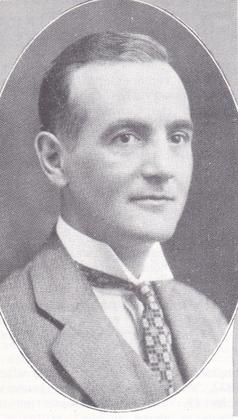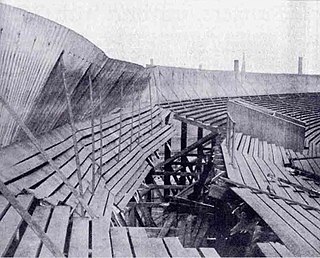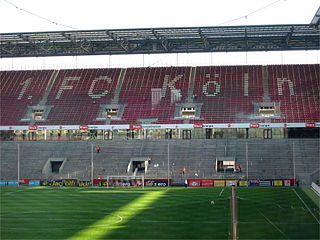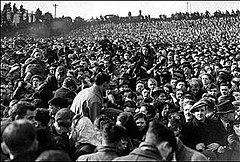
Bolton Wanderers Football Club is a professional football club based in Bolton, Greater Manchester, England, which competes in League One, the third level of the English football league system.

Ibrox Stadium is a football stadium on the south side of the River Clyde in the Ibrox area of Glasgow, Scotland. The home of Scottish Premiership team Rangers, Ibrox is the third-largest football stadium in Scotland, with an all-seated capacity of 51,700. The stadium was designed by renowned football stadium architect Archibald Leitch, with renovations to the stadium between 1978 and 1981, as well as 1990 and 1991, being designed by The Miller Partnership and Gareth Hutchison respectively.
The Hillsborough Stadium Disaster Inquiry report is the report of an inquiry which was overseen by Lord Justice Taylor, into the causes of the Hillsborough disaster in Sheffield, South Yorkshire, England, on 15 April 1989, as a result of which, at the time of the report, 95 Liverpool fans had died. An interim report was published in August 1989, and the final report was published in January 1990.

The Bradford City stadium fire occurred during a Football League Third Division match on Saturday, 11 May 1985 at the Valley Parade stadium in Bradford, West Yorkshire, England, killing 56 spectators and injuring at least 265. The stadium was known for its antiquated design and facilities, which included the wooden roof of the main stand. Previous warnings had also been given about a major build-up of litter in the cavity below the seats in the stand. The stand had been officially condemned and was due to be replaced with a steel structure after the season ended.

Burnden Park was the home of English football club Bolton Wanderers, who played home games there between 1895 and 1997. As well as hosting the 1901 FA Cup final replay, in 1946 it was the scene of one of the worst disasters in English football. The stadium was depicted in a 1953 painting by L. S. Lowry, Going to the Match.

Gresty Road or the Alexandra Stadium, currently known as the Mornflake Stadium for sponsorship reasons, is a football stadium in Crewe, Cheshire, England. The home ground of Crewe Alexandra, it has an all-seated capacity of 10,153.

Goronwy "Ronw" Moelwyn Hughes, KC, known as Moelwyn Hughes was a Welsh lawyer and a Liberal and Labour politician who was elected to two short terms as a Member of Parliament (MP).

The 1901–02 British Home Championship was an international football tournament between the British Home Nations which was meant to herald the arrival of the full professional game of football as both England and Scotland fielded fully professional teams for the first time. The championship was however dominated and overshadowed by a disaster during the final deciding match between England and Scotland at Ibrox Park, which claimed 25 lives. Six minutes into the game, a section of the wooden West Tribune Stand suddenly collapsed due to heavy rainfall the night before. Over 500 people were injured as the stadium was packed to its 68,000 capacity for the match. Although play was stopped in the immediate aftermath of the disaster as players, police and stewards rushed to aid the injured, it was later continued. The continued match finished 1–1 despite the players' reluctance and repeated pauses to allow police and injured spectators to cross the pitch. After the match the Scottish and English Football Associations decided to void the result, and the match was replayed at Villa Park. All proceeds from the replay were contributed to the Disaster Fund set up to aid victims of the accident.

A terrace or terracing in sporting terms refers to the standing area of a sports stadium, particularly in the United Kingdom and Republic of Ireland. It is a series of concrete steps, with intermittent safety barriers installed at specific locations to prevent an excessive movement of people down its slope.
Linthorpe Road was a cricket and football ground in Middlesbrough in England. It was the home ground of Middlesbrough Cricket Club and Middlesbrough F.C.
Thomas Lawrence Hamlett was an English footballer who played at right-back for Congleton Town, Bolton Wanderers, and Port Vale. He scored nine goals in 181 league appearances in the six seasons of the Football League immediately following World War II. He later spent 25 years on the coaching staff at Port Vale, from July 1958 to March 1983.

The 1923 FA Cup final was an association football match between Bolton Wanderers and West Ham United on 28 April 1923 at the original Wembley Stadium in London. The showpiece match of English football's primary cup competition, the Football Association Challenge Cup, it was the first football match to be played at Wembley Stadium. King George V was in attendance to present the trophy to the winning team.
The 1945–46 season was Stoke City's eleventh and final season in the non-competitive War League.

The 1971 Ibrox disaster, also known as the Second Ibrox Disaster, was a crush among the crowd at an Old Firm football game, which led to 66 deaths and more than 200 injuries. It happened on 2 January 1971 in an exit stairway at Ibrox Park in Glasgow, Scotland. It was the worst football disaster until the Bradford City stadium fire in Bradford, England, in 1985. This was followed by 97 deaths in the Hillsborough disaster in Sheffield, England, in 1989.

The 1902 Ibrox disaster was the collapse of a stand at Ibrox Park in Govan, Scotland. The incident led to the deaths of 25 supporters and injuries to 500 more during an international association football match between Scotland and England on 5 April 1902 as part of the 1901–02 British Home Championship.
Barley Bank was a cricket and football ground in Darwen in England. It was the home ground of Darwen F.C. during their time in the Football League.
The Town Ground was a football ground in Nottingham in England. It was the home ground of Nottingham Forest, and the first ground to host a football match using crossbars and goal nets.

Pike's Lane was a football ground in Bolton, England. It was the home ground of Bolton Wanderers between 1880 and 1895, and the venue of the first goal scored in league football anywhere in the world.
Wellington Road was a football ground in the Perry Barr area of Birmingham, England. It was the home ground of Aston Villa from 1876 until 1897.
Ibrox Park was a football ground in Ibrox, Scotland. It was the home ground of Rangers from 1887 until they moved to the adjacent second Ibrox in 1899. The ground staged the Scottish Cup Final four times and also three Scotland international matches.











